What is Omnichannel Customer Service Success

When you think about what is omnichannel customer service, it’s all about creating a seamless experience for your customers across every touchpoint. Whether they’re reaching out through social media, email, or a call, omnichannel ensures they feel valued and connected. This approach integrates all communication channels into one, offering consistency and convenience.
Unlike multichannel strategies, which operate in silos, omnichannel unifies everything into a single, cohesive system. This difference matters because fragmented experiences can frustrate customers. In fact, purchase rates in omnichannel customer experiences are 250% higher, and retention rates soar by 90%. It’s clear that when businesses adopt omnichannel, both you and your customers win.
Sobot exemplifies this approach by providing comprehensive solutions that enhance customer interactions across various channels.
Did you know? Companies with above-average customer experience management see 89% higher revenue growth compared to those with below-average efforts. That’s the power of putting your customers first.
Understanding What is Omnichannel Customer Service
Definition and Key Features
When you think about what is omnichannel customer service, it’s all about creating a unified experience for your customers across every communication channel. Whether they’re reaching out via email, social media, or a phone call, omnichannel ensures they feel connected and valued. This approach integrates all channels into one seamless system, making interactions smoother and more efficient.
Key features of omnichannel customer service include:
- Unified Communication: All customer interactions are consolidated into a single platform, so you can easily access their history and preferences.
- Personalization: Tailored experiences based on customer data, ensuring every interaction feels unique.
- Consistency: Whether your customers switch from chat to email or visit your store, they’ll enjoy the same level of service.
- Real-Time Insights: Analytics tools help you monitor performance and improve your strategies.
Here’s a quick look at some industry metrics that define the success of omnichannel strategies:
| KPI | Description |
|---|---|
| Engagement score | Measures the quality of omnichannel strategies and customer engagement. |
| Loyalty score | Indicates the number of customers who remain loyal to the brand. |
| Net Promoter Score (NPS) | Evaluates customer satisfaction and loyalty, helping to identify areas for improvement. |
Other important metrics include:
- Customer Satisfaction Score (CSS): Tracks how happy your customers are through surveys and feedback.
- Cross-channel Conversion Rate: Measures how many customers make purchases after engaging with your omnichannel strategy.
- Customer Lifetime Value (CLV): Assesses the total value of a customer throughout their journey with your brand.
These features and metrics show why omnichannel customer service is a game-changer for businesses aiming to enhance customer experience.
Differences Between Omnichannel and Multichannel Approaches
You might wonder, “How is omnichannel different from multichannel?” While both involve multiple communication channels, the way they operate is worlds apart.
Multichannel strategies often work in silos. For example, your email support might not connect with your social media team, leaving gaps in communication. This can frustrate customers who have to repeat their issues. On the other hand, omnichannel unifies all channels into one cohesive system.
Here’s a simple comparison:
| Feature | Multichannel Approach | Omnichannel Approach |
|---|---|---|
| Communication | Fragmented across channels | Unified across all channels |
| Customer Experience | Inconsistent | Seamless and consistent |
| Data Integration | Limited | Comprehensive |
| Efficiency | Lower due to silos | Higher due to streamlined processes |
Research shows that 89% of customers get irritated when they have to repeat their problems to multiple representatives. Companies with weak omnichannel strategies retain only 33% of their customers, while those with strong strategies retain up to 90%.
Omnichannel doesn’t just connect channels; it connects experiences. This integration makes it easier for you to deliver personalized and efficient service, keeping your customers happy and loyal.
Why Omnichannel is Essential for Customer Satisfaction
Customer satisfaction is the heart of any successful business. Omnichannel customer service plays a crucial role in achieving it. Why? Because it aligns with evolving customer expectations and provides the seamless experience they crave.
Studies show that omnichannel promotions, especially those tailored to shopping goals, significantly boost satisfaction. When you offer consistent service across channels, customers feel valued. This leads to higher loyalty and repeat purchases.
Take a look at how customer expectations have evolved over the years:
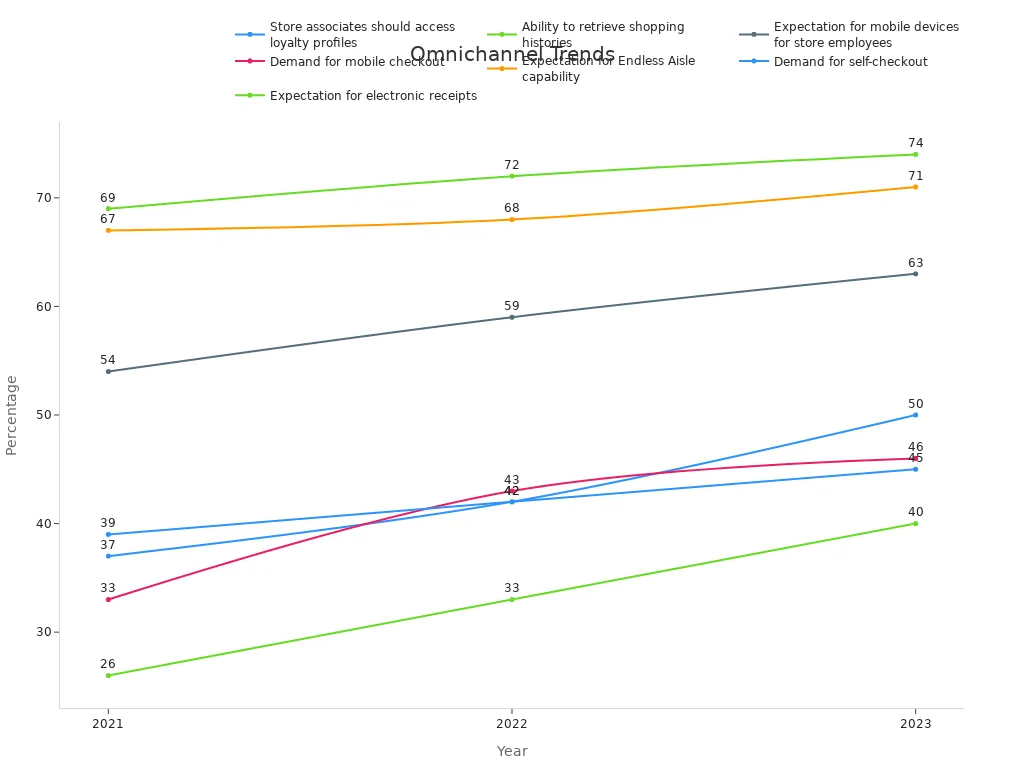
For example, in 2023, 50% of customers expected store associates to access loyalty profiles, up from 37% in 2021. Similarly, the demand for mobile checkout rose from 33% to 46% during the same period. These trends highlight the growing need for omnichannel solutions to meet customer demands.
The market for omnichannel customer service is also expanding rapidly. In 2023, it was valued at USD 14.2 billion, with projections reaching USD 35.6 billion by 2032. This growth reflects the rising demand for personalized and consistent experiences.
When you adopt omnichannel strategies, you’re not just improving customer satisfaction—you’re building lasting relationships. Customers who feel understood and valued are more likely to stay loyal, recommend your brand, and contribute to your success.
Real-World Examples of Omnichannel Customer Service Success

Case Study: Samsung's Collaboration with Sobot
Samsung, a global leader in technology, faced a challenge familiar to many large businesses: managing a high volume of customer inquiries across multiple channels. They needed a solution that could unify their communication systems and improve efficiency. That’s where Sobot stepped in.
By implementing Sobot's all-in-one contact center solution, Samsung transformed its customer service operations. The platform integrated various communication channels, allowing agents to handle inquiries seamlessly without switching systems. It also connected with Samsung's internal tools, like ERP and ticketing systems, ensuring agents had access to complete customer histories. This eliminated repetitive questioning and improved the overall experience for customers.
The results were remarkable:
- A 30% increase in agent efficiency.
- Customer satisfaction (CSAT) soared to 97%.
Samsung also introduced personalized services for VIP customers, such as video support, which strengthened loyalty. This collaboration highlights how a robust omnichannel strategy can drive success by enhancing both efficiency and customer experience.
Case Study: Amazon's Seamless Online and Offline Integration
Amazon has mastered the art of blending online and offline channels to create a truly omnichannel experience. Whether you’re shopping on their website, using their mobile app, or visiting an Amazon Go store, the experience feels consistent and interconnected.
Amazon’s approach focuses on reducing friction and enhancing convenience. For instance, their mobile app syncs with physical stores, allowing you to scan items and check out without waiting in line. Alexa, their voice assistant, adds another layer of integration by enabling voice commands for shopping and customer support.
Here’s a snapshot of the impact Amazon’s strategy has had:
| Metric | Value |
|---|---|
| Cart Abandonment Reduction | 10-20% |
| Conversion Rate Increase | 5-10% |
| Customer Lifetime Value Increase | 30% |
| Customer Acquisition Cost Reduction | 15-30% |
This seamless integration has not only improved customer satisfaction but also boosted loyalty. Amazon’s ability to unify online and offline channels demonstrates the power of omnichannel strategies in delivering a superior customer experience.
Case Study: Starbucks' Mobile App and Loyalty Program
Starbucks has redefined customer engagement with its mobile app and loyalty program. The app allows you to order ahead, earn rewards, and even customize your drinks—all while enjoying a consistent experience across channels.
The loyalty program has been a game-changer. Members receive personalized offers based on their preferences, encouraging repeat visits. The app also integrates with in-store systems, ensuring a smooth experience whether you’re ordering online or picking up in person.
Here’s how Starbucks’ strategy has paid off:
| Metric | Result |
|---|---|
| Active Members | 29M+ Globally |
| Repeat Visits | +35% Growth |
| Customer Retention | +40% Improvement |
| Mobile Order Share | 25% of Total Orders |
| Repeat Purchases | +30% Growth |
| App Engagement Rate | +45% Increase |
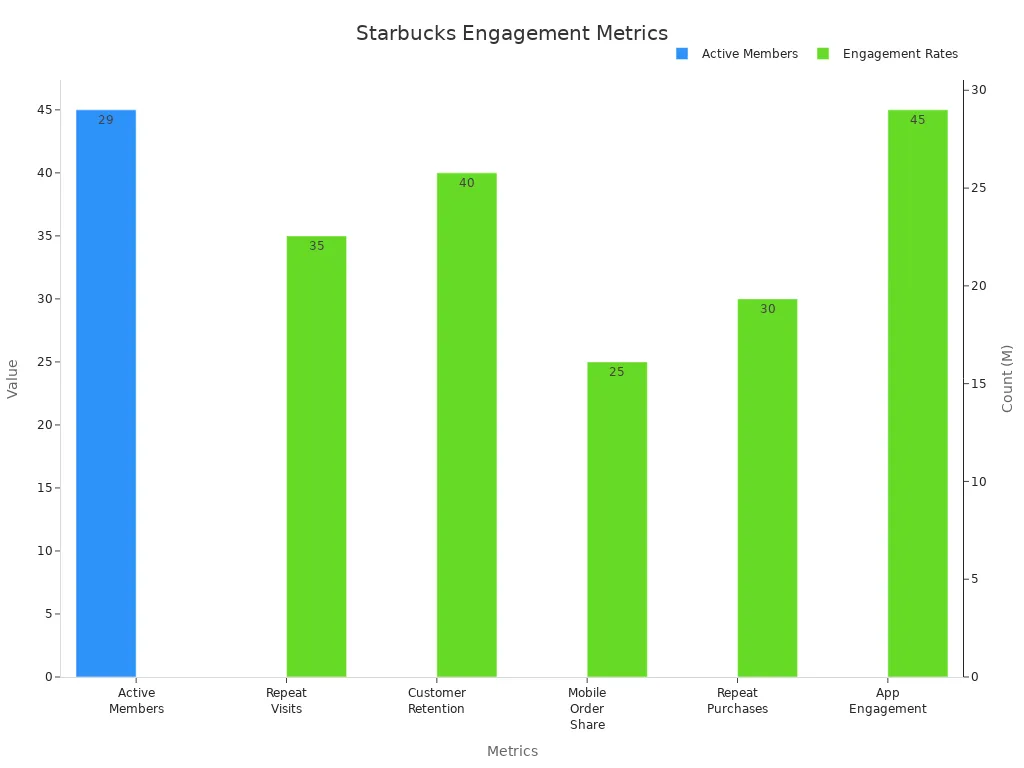
Additionally, 31 million active U.S. members contribute to 41% of Starbucks’ U.S. sales. Members are 5.6 times more likely to visit daily, and 71% of app users visit at least once a week. These numbers prove that Starbucks’ omnichannel approach has not only enhanced customer retention but also driven significant growth in engagement and revenue.
Key Takeaways from Successful Implementations
When you look at successful omnichannel implementations, the results speak for themselves. Businesses that embrace this strategy don’t just improve their operations—they transform the entire customer experience. Let’s break down the key lessons from these success stories.
1. Unified Channels Drive Better Results
One of the biggest wins of omnichannel is how it connects online and offline channels into a seamless system. This integration eliminates silos and ensures customers enjoy consistent service, no matter where they interact with your brand. For example, Samsung unified its communication channels using Sobot’s platform, boosting agent efficiency by 30% and achieving a 97% customer satisfaction rate.
2. Enhanced Customer Loyalty and Retention
Omnichannel strategies don’t just attract customers—they keep them coming back. Research shows that customer retention rates are 91% higher for businesses with strong omnichannel systems compared to multichannel competitors. This loyalty stems from the personalized and consistent experiences customers receive across all touchpoints.
3. Increased Revenue and Purchase Rates
The financial benefits of omnichannel are undeniable. Campaigns using this approach see purchase rates 287% higher than single-channel campaigns. Additionally, order values increase by 13%, and customer lifetime value rises by 30%. These numbers highlight how omnichannel strategies directly impact your bottom line.
| Metric | Improvement Percentage/Value |
|---|---|
| Purchase rate compared to single-channel | 287% higher |
| Order value increase | 13% |
| Customer lifetime value | 30% higher |
| Customer retention increase | 91% higher |
| Curbside pickup orders increase | 208% increase |
4. Adaptability to Changing Customer Needs
Successful implementations show how omnichannel strategies adapt to evolving customer expectations. During the pandemic, curbside pickup orders rose by 208%, proving the importance of flexibility. Starbucks’ mobile app and loyalty program are another great example. By offering personalized rewards and integrating online and offline channels, Starbucks saw a 40% improvement in customer retention and a 35% growth in repeat visits.
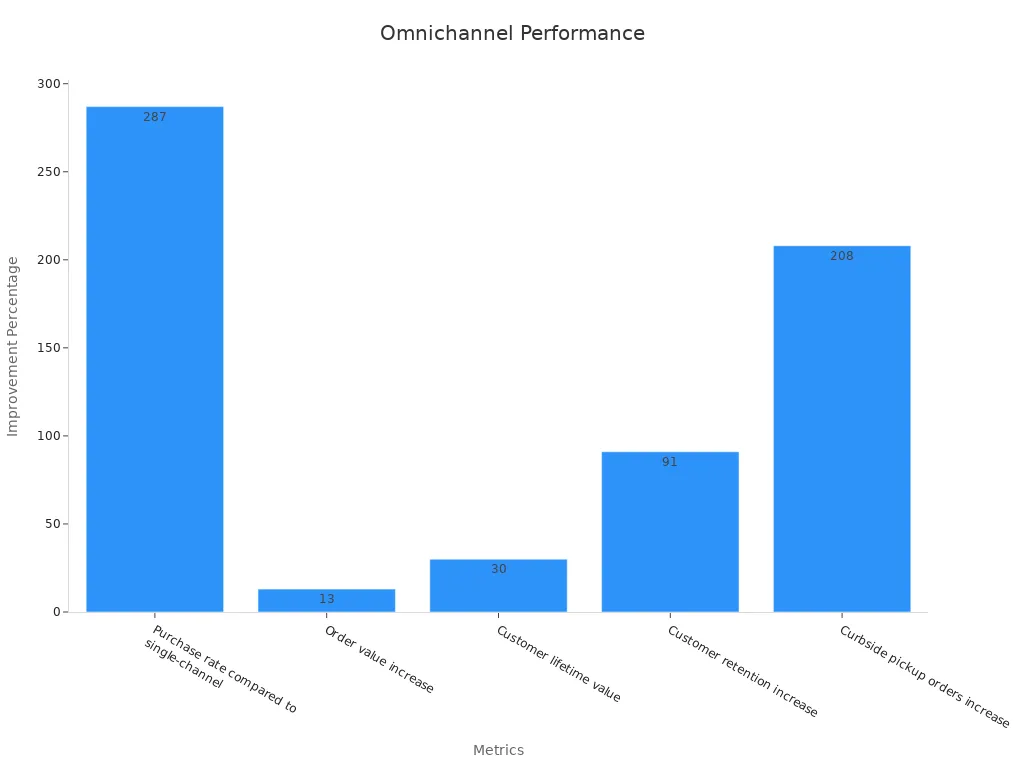
5. The Role of Technology in Success
Technology plays a crucial role in making omnichannel strategies work. Tools like Sobot’s Voice/Call Center and AI-powered chatbots simplify communication and enhance customer interactions. These solutions unify customer data, automate repetitive tasks, and provide real-time insights, helping you deliver exceptional service.
Tip: Investing in the right tools, like Sobot’s omnichannel solutions, can improve productivity by 30% and reduce operational costs.
6. Personalized Experiences Build Stronger Connections
Personalization is the cornerstone of omnichannel success. Customers want to feel understood and valued, and tailored experiences make that happen. Whether it’s Amazon’s Alexa-enabled shopping or Starbucks’ customized rewards, personalization strengthens customer loyalty and drives repeat purchases.
These takeaways show why omnichannel isn’t just a strategy—it’s a necessity for modern businesses. By unifying channels, leveraging technology, and prioritizing personalization, you can create experiences that keep customers happy and loyal.
Essential Components of Omnichannel Customer Service Success
Customer Journey Mapping
Understanding your customers’ journey is the first step toward delivering a seamless experience. Customer journey mapping helps you visualize every interaction a customer has with your brand, from their first touchpoint to post-purchase support. This process allows you to identify pain points, streamline onboarding, and improve customer retention by addressing critical intervention areas.
Metrics like conversion rates, customer lifetime value, and churn rate validate the effectiveness of journey mapping. For example:
- It aligns with real customer behavior, helping you visualize actual paths.
- It unifies customer data, encouraging collaboration across teams.
- It grades and improves customer experience across multiple touchpoints.
By mapping the journey, you can create a customer-centric service that not only meets expectations but exceeds them. Tools like Sobot’s omnichannel solution make this process easier by consolidating data and providing actionable insights. This integrated approach ensures your customers enjoy a seamless shopping experience every step of the way.
Integration of Communication Channels
Imagine a world where your email, social media, and phone support all work together. That’s the power of integrating communication channels. It eliminates silos, enabling your team to deliver consistent and efficient service. This integration boosts productivity and enhances customer satisfaction.
Here’s what the numbers say:
| Statistic | Percentage |
|---|---|
| Lack of effective collaboration and communication as a cause of failures | 86% |
| Increase in productivity due to effective communication | Up to 25% |
| Business leaders believing effective communication increases productivity | 64% |
| Knowledge workers agreeing on increased productivity | 55% |
| Employees feeling included in communication reporting increased productivity | Almost 500% |
Sobot’s Voice/Call Center exemplifies this integration. It unifies customer interactions across channels, offering features like smart call routing and real-time monitoring. With a 99.99% system uptime, it ensures your team stays connected and productive, no matter where your customers reach out.
Personalization and Tailored Experiences
Personalization is the secret sauce of customer loyalty. When you tailor your service to individual preferences, customers feel valued and understood. This approach drives engagement, boosts retention, and strengthens long-term relationships.
Research shows that personalization can increase average revenue by 10-25%. Additionally:
- 91% of consumers prefer brands that recognize and provide relevant offers.
- Businesses using advanced personalization strategies report a 90% increase in retention rates.
Sobot’s omnichannel marketing tools make personalization effortless. By leveraging AI-driven insights, you can deliver personalized marketing campaigns and tailored experiences across all channels. Whether it’s a chatbot offering product recommendations or a loyalty program rewarding frequent buyers, personalization transforms your customer experience into something unforgettable.
Consistent Branding Across Channels
When it comes to delivering a great customer experience, consistent branding across all channels is key. Imagine walking into a store that feels completely different from its website. It’s confusing, right? That’s why keeping your branding consistent matters. It helps customers recognize your business instantly, no matter where they interact with you.
Consistency isn’t just about using the same logo or colors. It’s about creating a unified tone, message, and style across every channel. Whether your customers are chatting with your support team, scrolling through your social media, or visiting your physical store, they should feel like they’re interacting with the same brand. This builds trust and makes your business memorable.
Here’s how you can ensure consistent branding:
- Use the same tone of voice: Whether it’s a chatbot or a live agent, your communication should reflect your brand’s personality.
- Align visuals and design: Keep your logos, fonts, and colors uniform across all platforms.
- Train your team: Make sure everyone understands your brand values and knows how to represent them.
Take Starbucks as an example. Their mobile app, loyalty program, and in-store experience all feel connected. This consistency strengthens their brand and keeps customers coming back.
With tools like Sobot’s omnichannel solutions, you can unify your communication channels and maintain consistent branding effortlessly. These tools help you deliver a seamless experience while ensuring your brand stays recognizable and trustworthy.
Pro Tip: Consistent branding doesn’t just improve customer loyalty—it also boosts your credibility. Customers are more likely to trust a brand that feels cohesive and professional.
Tools and Technologies for Omnichannel Success

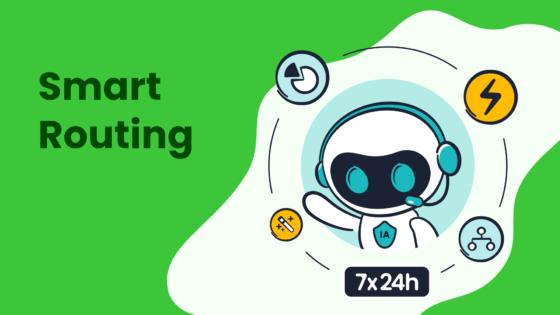
Sobot's Voice/Call Center and Its Role in Omnichannel Strategy
When it comes to creating a seamless shopping experience, Sobot's Voice/Call Center is a game-changer. It integrates voice communication into your omnichannel strategy, ensuring your customers can connect with you effortlessly across online and offline channels. This tool doesn’t just handle calls—it transforms them into opportunities for better customer engagement.
Here’s what makes Sobot’s Voice/Call Center stand out:
- Smart Call Routing: Calls are automatically directed to the right agent, reducing wait times.
- AI-Powered Voicebot: Handles repetitive queries, freeing up agents for complex issues.
- Global Reach: With access to phone numbers worldwide, you can support customers anywhere.
The results speak for themselves:
| Metric | Value |
|---|---|
| Reduction in inbound discussion volume | 20% |
| Positive feedback rate | 96%+ |
| Correct answers provided by AI | 80% |
| Customer satisfaction rate | 95% |
| Self-service question resolution | 22.2% |
| Customer satisfaction score (CSAT) | 97% |
| Problem resolution rate | 85% |
| Customer happiness rate | 99% |
| Sign-off rate increase | 35% |
| COD collection rate increase | 40% |
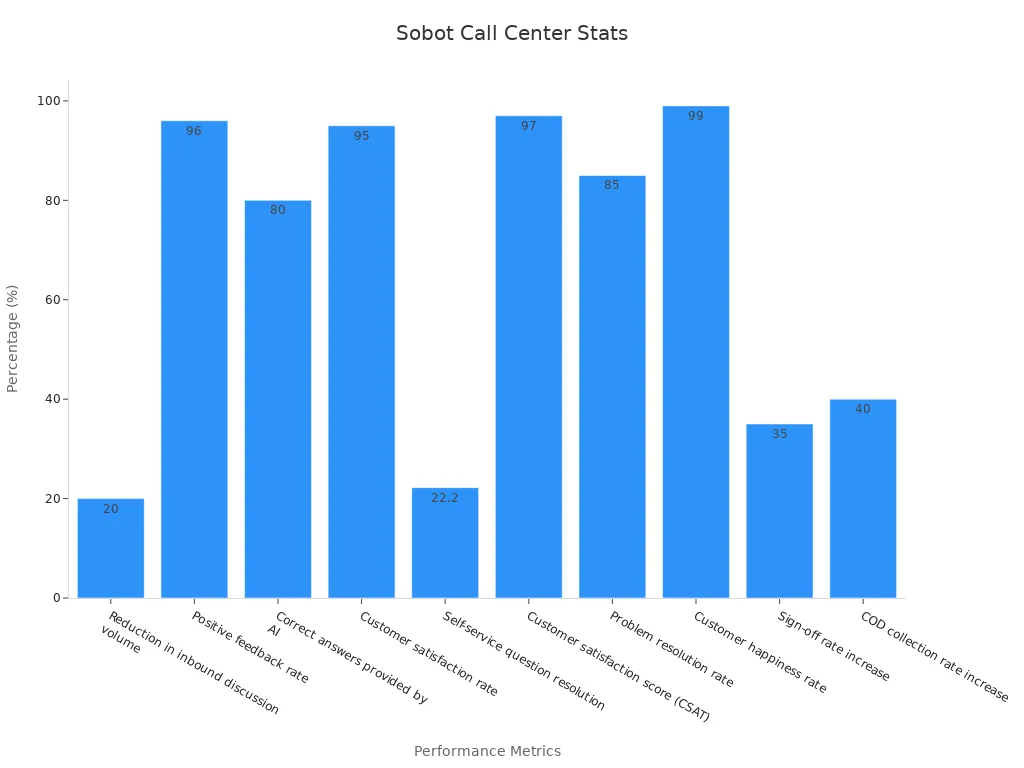
By integrating Sobot’s Voice/Call Center, you can enhance customer satisfaction and improve operational efficiency, making it a vital tool for omnichannel retailing.
CRM Systems for Unified Customer Data
A robust CRM system is the backbone of any successful omnichannel commerce strategy. It unifies customer data, giving you a 360-degree view of every interaction. This means you can deliver personalized experiences and ensure consistency across all touchpoints.
Here’s how companies have leveraged CRM systems:
- Company A's Strategy: Enhanced customer engagement and drove sales through a seamless omnichannel experience.
- Unified Experience: Integrated e-commerce with physical stores, enabling real-time inventory checks and flexible purchase options.
- Personalized Messaging: Used CRM data to send tailored offers, boosting engagement rates.
- Mobile App Integration: Developed an app for exclusive deals and personalized recommendations.
- Loyalty Program: Unified across channels, increasing customer retention and participation.
With a CRM system, you can align your omnichannel marketing efforts, improve customer retention, and build stronger relationships.
AI and Chatbots for Enhanced Customer Support
AI and chatbots are revolutionizing customer support by making it faster and more efficient. They handle repetitive tasks, provide instant responses, and free up your team to focus on complex issues. This technology is a must-have for any omnichannel strategy.
Here’s what businesses have achieved with AI and chatbots:
- A leading e-commerce company reduced response times by 60% and increased customer satisfaction scores by 25%.
- A global retailer cut support costs by 40% and improved agent efficiency by 30%.
| Outcome | Measurement |
|---|---|
| Reduction in response times | Up to 40% |
| Increase in customer satisfaction | Notable increases reported |
| Cost reduction | Streamlined operations leading to measurable savings |
AI-powered tools like Sobot’s chatbot take personalization to the next level. They analyze customer data to offer tailored recommendations, ensuring every interaction feels unique. By adopting AI, you can enhance the customer experience and drive success in your omnichannel approach.
Analytics Tools for Measuring Performance
Analytics tools are the backbone of any successful omnichannel strategy. They help you measure how well your customer service is performing and identify areas for improvement. By tracking the right metrics, you can ensure your customers enjoy a seamless experience every time they interact with your brand.
Some of the most effective metrics include:
- Customer Satisfaction Score (CSAT): This measures how happy your customers are with your service.
- Net Promoter Score (NPS): It shows how likely your customers are to recommend your business to others.
- Customer Lifetime Value (CLV): This helps you understand the total value a customer brings to your business over time.
- First Contact Resolution (FCR): This tracks how often customer issues are resolved on the first try.
- Average Handle Time (AHT): This measures how long it takes to handle a customer inquiry.
These metrics aren’t just numbers. They give you insights into what’s working and what needs improvement. For example, a high FCR means your team is resolving issues quickly, which boosts satisfaction. On the other hand, a low CSAT might signal a need for better training or tools.
Real-time data evaluation is another game-changer. It allows you to respond to customer needs instantly, improving service delivery. Imagine spotting a spike in wait times and addressing it before it affects satisfaction. That’s the power of real-time analytics.
By using tools like Sobot’s omnichannel solutions, you can track these metrics effortlessly. They provide a unified view of your performance, helping you make data-driven decisions that enhance the customer experience.
Pro Tip: Regularly review your analytics to stay ahead of customer expectations and keep your service top-notch.
Overcoming Challenges in Omnichannel Implementations
Common Challenges Businesses Face
Implementing an omnichannel strategy isn’t always smooth sailing. Many businesses encounter hurdles that can slow down progress or impact the customer experience. Let’s explore some of the most common challenges:
- Retention and Loyalty: Keeping customers engaged across multiple channels can be tricky. If the experience feels inconsistent, they may lose trust in your brand.
- Data Integration: Fragmented data across platforms makes it hard to create a unified customer profile. This can lead to missed opportunities for personalization.
- Omnichannel ROI: Measuring the return on investment for omnichannel efforts can be complex, especially when tracking performance across different touchpoints.
- Inventory and Fulfillment: Managing inventory and ensuring timely fulfillment across channels is another major challenge.
- Customer Satisfaction: Poorly integrated systems can lead to longer wait times and unresolved issues, frustrating your customers.
These challenges highlight the importance of a well-planned strategy to ensure omnichannel success.
Practical Solutions for Seamless Integration
Overcoming these challenges requires actionable solutions. Here’s how you can tackle them effectively:
- Develop a Unified Customer Profile: Consolidate data from all channels to create a single view of each customer. This allows you to deliver personalized experiences that build loyalty.
- Maintain Consistent Branding: Ensure your messaging, tone, and visuals are uniform across all touchpoints. This consistency builds trust and strengthens your brand identity.
- Integrate Communication Channels: Use tools like Sobot’s omnichannel solutions to unify your channels. This integration ensures a seamless experience for your customers and improves operational efficiency.
By adopting these strategies, you can reduce overhead costs, improve engagement rates, and make data-driven decisions that enhance your omnichannel efforts.
Training Teams for Omnichannel Excellence
Your team plays a crucial role in delivering a successful omnichannel experience. Proper training ensures they’re equipped to handle the complexities of this approach. Here’s how you can prepare your team:
- Define Clear Metrics: Set performance goals that align with your omnichannel objectives. This gives your team a clear understanding of what’s expected.
- Provide Regular Feedback: Create a culture of continuous improvement by offering constructive feedback. This helps your team refine their skills and adapt to new challenges.
- Iterative Training Programs: Use performance evaluations to identify areas for improvement and tailor training sessions accordingly.
For example, a telecommunications company implemented a training program focused on empathy and channel-specific skills. The result? A 25% increase in customer satisfaction scores and a 20% drop in complaints. This shows how investing in your team can lead to measurable improvements in service quality.
Tip: Equip your team with tools like Sobot’s omnichannel platform to streamline their workflows and enhance productivity.
Ensuring Data Security and Privacy
When you’re running an omnichannel strategy, keeping customer data safe should be one of your top priorities. Customers trust you with their personal information, and it’s your job to protect it. A single data breach can damage that trust and hurt your reputation. So, how do you ensure data security and privacy while managing multiple communication channels?
Here are some proven measures you can take:
- Secure Data Storage: Store customer information in encrypted databases. This prevents unauthorized access and keeps sensitive data safe.
- Access Controls: Limit who can access customer data. Only authorized employees should have permission to view or edit it.
- Regular Audits: Conduct frequent data audits to identify vulnerabilities. This helps you stay compliant with laws like GDPR and CCPA.
You also need to focus on building trust with your customers. High-profile breaches have made people cautious about sharing their information. Be transparent about how you collect, store, and use their data. Proactive communication reassures them that their privacy matters to you.
Training your team is another critical step. Employees should know how to handle customer data responsibly. Regular workshops and updates on privacy best practices can reduce risks.
Technology plays a big role too. AI-driven platforms, like those used by NICE Systems Limited, can securely manage customer interactions across channels. These tools enhance data protection while improving efficiency.
By combining these strategies, you can create a secure environment for your customers. When they feel safe, they’re more likely to trust your brand and stay loyal. After all, protecting their data isn’t just a legal requirement—it’s a way to show you care.
Tip: Always stay updated on the latest privacy regulations. It’s a simple way to avoid penalties and keep your customers happy.
Omnichannel customer service isn’t just a trend—it’s a game-changer for businesses aiming to thrive in today’s competitive market. By unifying communication channels, you can deliver seamless, personalized experiences that keep customers coming back. The benefits are clear:
| Metric | Omnichannel Strategy | Non-Omnichannel Strategy |
|---|---|---|
| Year-over-year customer retention rates | 91% | N/A |
| Customer lifetime value | 30% higher | N/A |
| Annual revenue increase | 9.5% | 3.4% |
| Cost per contact decrease | 7.5% | 0.2% |
| Customer expectation for consistent interactions | 90% | N/A |

Investing in advanced tools like Sobot’s omnichannel solutions and training your team ensures you’re ready to meet evolving customer expectations. Enhanced customer satisfaction, increased sales, and better inventory management are just a few of the rewards.
Pro Tip: Prioritize seamless customer experiences to build loyalty and stay ahead of the competition. Your customers will thank you, and your business will thrive.
FAQ
What is the difference between omnichannel and multichannel customer service?
Omnichannel connects all communication channels into one system, creating a seamless experience. Multichannel uses separate systems for each channel, which can lead to inconsistent service. Omnichannel ensures customers don’t repeat themselves, while multichannel often leaves gaps in communication.
How can omnichannel customer service improve customer satisfaction?
It makes interactions smoother and more personalized. Customers get consistent service across all channels, which builds trust and loyalty. Plus, faster resolutions and tailored experiences make them feel valued.
What tools are essential for implementing omnichannel strategies?
You’ll need CRM systems for unified customer data, AI-powered chatbots for automation, and analytics tools to measure performance. Platforms like Sobot’s Voice/Call Center integrate these features to simplify operations and enhance customer experiences.
Is omnichannel customer service suitable for small businesses?
Absolutely! Small businesses benefit from streamlined communication and improved efficiency. Tools like Sobot’s solutions offer scalable options that fit businesses of all sizes, helping you deliver exceptional service without breaking the bank.
How does omnichannel customer service protect customer data?
It uses encrypted databases, access controls, and regular audits to keep data secure. Transparency about data usage builds trust, while training your team ensures responsible handling of sensitive information.
See Also
Essential Insights for Choosing Omnichannel Call Center Tools
Ten Key Steps for Deploying Omnichannel Contact Centers
Enhancing E-commerce Customer Satisfaction with Chatbot Technology
